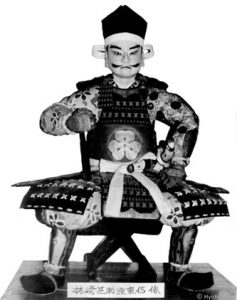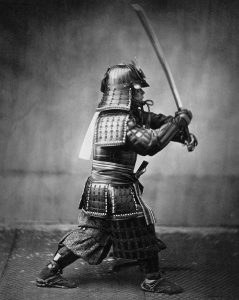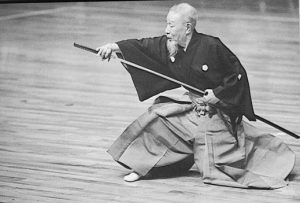Tamiya Ryu Iaijutsu History

Tamiya Ryū (Iaijutsu) has been passed down to the present day through various circumstances. Approximately 400 years ago, Hayashizaki Jinsuke Shigenobu (? c. 1546-1621), the founder of Shin Musō Hayashizaki Ryū, began to pass on his immediate teachings to Tamiya Heibei Shigemasa (Note: Depending on the text, the names Narimasa, Narimatsu, Shigetada or Shigematsu are used instead of Shigemasa). From among the pupils of Hayashizake Jinsuke emerged the founders of Mugai Ryū (Nagano Muraku Kinrōsai), Sekiguchi Ryū (Sekiguchi Hachiroemon Jushin) and Hoki Ryu (Katayama Hoki no Kami Hisayasu).
It has been said that Shigemasa, the founder of Tamiya Ryū, was born in the Kanto region (Note: On page 83 of Gordon Warner and Don F. Draeger’s text entitled Japanese Swordsmanship: Technique and Practice, it is stated more specifically that he was born in Iwamurata in Jōshū, or Gunma Prefecture as it is known today). Shigemasa first took lessons in Musō Ryū from Higashi Shimotsuke no Kami, and later pursued a course of study in Shin Musō Hayashizaki Ryū under the guidance of Hayashizaki Jinsuke himself, adding his own ideas to what he was taught. It is said that he then attained the secrets of Shin Musō Hayashizaki Ryū, but with regard to his physical appearance there are no details available.
However, there is an anecdote concerning the word: 長柄刀 (Nagaekatana, or Long-hilted Sword) that has been handed down from generation to generation to modern times. Shigemasa intentionally wore a sword with a longer hilt, explaining that: “A longer sword is more advantageous.” He continued, teaching that the strong point of the Nagaekatana lies in the fact that: “ One can anticipate a threefold benefit by virtue of having a hilt that is 8 Sun (or approximately 9.5 – 10.0 inches)”. Furthermore, in the section of The Record of Hōjō Sōun entitled The Secret Mysteries of Sōhō by Kubota Kiyone, the following explanation of this teaching is given:
“Given two swords that are the same in length, if the hilt of one is 2 Sun (or approximately 2.5 inches) longer there will be, in this case, the threefold advantage mentioned previously. First of all, it will be difficult for the opponent to reach me but it will be easy for me to reach him, resulting in an 8 Sun benefit altogether. Second, if the Nagaekatana is held overhead (in Jōdan no Kamae), it will be good for looking down at the opponent, while the opponent will have to look up some distance. Third, because the opponent must come closer, I have another advantage because conversely, I can reach the opponent without a need to come closer, so all in all, I have a threefold advantage. This is what is called Mikoshi Sanju Ri no Shinmyo Nagae Denju or The Mysterious Teaching of the Three Foreseen Advantages of the Long Hilt.”
Nevertheless, the Schools of Iai that existed during the Sengoku (Civil War) Period profited from the use of a long-hilted sword.
Tamiya Ryū heir Tsushima no Kami Nagakatsu succeeded Shigemasa, and it is said that their style was first called Tamiya Ryū during this era. From childhood, Nagakatsu received his training from Shigemasa, during which time he was given the childhood nickname Mihira (or Mitsudaira). It has been said that Nagakatsu had a bad habit with respect to his front leg when he would draw his sword during the performance of Iai; a habit that he was unable to correct, despite all of his efforts. So Shigemasa, drawing a fine sword that he had received from the Shōgun, proceeded to prick Nagakatsu’s thigh each time he erred, and from that time forward, Nagakatsu’s bad habit was corrected.
Concerning Nagakatsu’s role at Sekigahara (c. 1600), he served Ikeda Terumasa (in power from 1584 to 1613 – Warner & Draeger, Ibid. p.84) and because of his remarkable service at the Ōsaka winter battle (1614) was praised to Tokugawa Ieyasu. It is also said that he became a vassal of Tokugawa Yorinobu, the master of Hamamatsu Castle and received a stipend of 800 Tepposhū (musketeers), but I do not know if this particular fact is right or wrong. (Note: On page 122 of the text Miyamoto Musashi: His Life & Writings by Tokitsu Kenji, the following is mentioned: “Tamiya Nagakatsu, an Iai Master, received 800 koku from Lord Tokugawa of Hamamatsu Castle. His son, Tamiya Heibei, the founder of Tamiya Ryū Battōjutsu, first received 250 koku and then 800 koku when he succeeded his father.”) Later, in 1619 when Yorinobu moved to Kishū (present day Wakayama Prefecture), Nagakatsu followed him, and it was here that Nagakatsu’s son, Tamiya Heibei Nagaie, inherited the family estate.
Nagaie (the third successive generation of the line beginning with Tamiya Heibei Shigemasa), together with Kimura Jokurō (a pupil of Yagyū Munenori) and others, offered their respective Styles to Iemitsu, the third Tokugawa Shogun, for formal inspection on March 6 of the year 1651 (Keian Yonnen). In the work by Bōten entitled Daiken Inten Gojikki, there is an entry that is like the one that follows:“Kimura Jokurō, a fencer of the feudal domain of Ki, and Iainuki practitioner Tamiya Heibei were summoned to the Imperial residence so that their arts could be inspected. Both men were given appropriate clothing and ten pieces of silver.”This was, to be sure, a great honor for Nagaie, but for the school known as Tamiya Ryū, it can be said that it was an event of great consequence since the entire country came to know that name well.
Tamiya Sannnosuke Asanaru was the fourth of the Tamiya line and successor to Nagaie. However, in the year 1668 (Kanbun Hachinen) Asanaru, on top of having a weak constitution, suffered a series of physical misfortunes and was forced to spend the rest of his life in obscurity. It was then that the fifth heir of the Tamiya line, Tamiya Jirouemon Narumichi succeeded him.
Narumichi not only worked to restore the family’s fortunes, but also focused his efforts on guiding the pupils of Tamiya Ryū. Those labors were rewarded as the number of pupils grew and became many. Narumichi rose in prominence and in 1718 (Kyōhō Sannen) created a governing body of 10 persons.

Nevertheless, although the School continued for generations through a direct line of blood relatives, it was its fate to come to an end, as Narumichi was eventually struck down by illness. Both before and after this, Narumichi’s legitimate child was not able to inherit the family techniques handed down from father to son, also due to illness. So, in 1734 (Kyōhō Jyūnen) the family estate passed to the eldest son (a grandchild by Narumichi’s heir), but he was obliged to turn over the family art of Tamiya Ryū to pupil Nakamura Zeuemon.The fifth generation lasted about 100 years, guarding the lineage. Tamiya Ryū was also handed down during this period, but in an unexpected turn of events, ended up completely losing its legitimacy.
Nakamura Zeuemon, who inherited Tamiya Ryū after Tamiya Jirouemon Narumichi, changed his full name to Tamiya Chiuemon so that the Tamiya family name would not die out. However, the details concerning Chiuemon’s achievements have not been passed down, and the actual date of his death is not certain.
Until Narumichi, the Style that continued to be handed down to the direct descendants of the Tamiya line was known as Ko Tamiya Ryū, but after Chiuemon it became known as Kishū Tamiya Ryū. In addition (according to popular opinion), Wada Hirasuke Seishō of the feudal province of Mito and a direct descendant of the Miwa family revived the art of Tamiya Ryū, calling it Shin Tamiya Ryū. Furthermore, Hirasuke himself wrote Yo ga Ichiban (To Give is Best), which can be found in an article by Yamada Jirokichi that was published in Kendō Sōsho (The Kendō Series). Hirasuke succeeded in establishing Tamiya Ryū for future generations, like Yamashita Yūbei. Collectively, these three lines are called Tamiya San Ryū.
The Style known as Kishū Tamiya Ryū spread to the feudal domain of Iyo Saijō (present-day Ehime Prefecture), and achieved great success as Tamiya Shinken Ryū (whose curriculum included both Kenjutsu and Iai).
The sequence of events that led to this development started in the year 1670 (Kanbun Jūnen) when Yorizumi, the second son of Dainagon Matsudaira Yorinobu of the domain of Kii, began to pass on Kishū Tamiya Ryū in Iyo Saijō Province, which was a branch of the Kishū family. This was accomplished through the efforts of Eda Gizaemon (a follower of Tamiya Tsushima no Kami Nagakatsu), who is considered to be the third (Sandai) of the Kishū Tamiya Ryū line beginning with the founder, Shigemasa (Shodai), followed by his son Nagakatsu (Nidai). By the way, the year 1670 is also the year in which Tamiya Heibei Shigemasa died.After that, the Style’s lineage continued with Miyake Shui; Kurimoto Hanzo; Sanno Bangoro, who was called ‘ The God of War’; Toyota Nakazaemon and Toyota Chikazaemon so that, by the middle of the Edo Period, it had taken the world by storm.
Then, in 1800 (Kansei Kyūnen) Tsumaki Junjiro Motoaya inherited the Tamiya Style, becoming the eighth (Hachidai) of the line. Since that time the Tsumaki family has protected and passed on Tamiya Ryū as a family art through the transmission of its secret teachings from father to son. Unfortunately, there are no facts regarding how Tsumaki Junjiro Motoaya came to inherit Tamiya Shinken Ryū, but as for the questions concerning 1) why, as Toyota Nakazaemon’s leading student, he came to be well known in the Han (Province) and 2) why there was no person in the family of Toyota Chikazaemon who was able to inherit this art, these two guesses might be made.
Tsumaki Junjiro Motoaya was born as the child of Ōkyūtamo Onuemon and later entered the Tsumaki family. He entered government service in 1780 (An’ei Kyūnen), receiving a hereditary stipend of forty koku. A frugal man, he later worked as both a District Magistrate and Construction Magistrate, while it also seems that he undertook a careful study of Uchida Ryū Hōjutsu (Gunnery). On April 24, 1822 (Bunsei Yonnen), Tsumaki Junjiro Motoaya died due to disease and on July 11 of the same year, Tsumaki Nobuhira Motomoro succeeded to the position of 9th Headmaster. Nobuhira was not Junjiro’s direct heir, but was the adopted son of another family with the Tsumaki name. In 1821, at the command of the Han, the young Nobuhira was specially chosen to travel to Edo in order to master Confucianism at the Yujima Confucian Temple. Nobuhira inherited Tamiya Shinken Ryū more than one year later and, it appears, was extraordinary with regard to his skills in scholarship and the martial arts. However, in May of 1824 Nobuhira died in Iyo Saijō due to illness.
Nobuhira’s successor was his younger sister’s husband, Washimi Kenjiro, who later became Tsumaki Heinojo Motoshige when the Tsumaki family adopted Nobuhira’s younger sister and took Kenjiro into the Tsumaki family as a son-in-law. The Washimi family served as chief retainers to the Han, achieving importance as a distinguished family and in December of 1834 (Tempō Yonnen), while in Edo, Kenjiro changed his name to Tsumaki Heinojo Motoshige.
There is, at the present time, a letter that was left to the Tsumaki family that was written by Heinojo’s father, Washimi Daizen Shinsei, and whose contents are said to include not only admonitions from father to son, but also knowledge of the School. I will try to introduce a part of this letter in the section that follows.
“If you are excessive in scholarship, you will lapse into laziness; if you are excessive in the martial arts, you will become violently strong. When both ways are imperfect, it is also harmful. If a cart lacks one of its wheels, or if a bird loses one of its wings, you cannot be called a true warrior (makoto no bushi). Thinking deeply is essential. You must be careful not to allow your behavior to drift from the path of loyalty and filial piety, even for a moment. It cannot seem as if you are concealing your own illustrious virtue under a cover for the purpose of your own self-interest. Within the heart, safety in study is important. (Section omitted here.) In everything, there are two things: calmness and urgency. When facing calamities, if the heart is not calm, it will become afraid. In a case like that, calm the heart and if you can forgive the reason, be it right or wrong, your troubles will be few.”
Heinojo died on August 12, 1863 (Bunkyō Ninen) in Iyo Saijō. His second son, Tsumaki Ataka Motonari (or Gensei), succeeded him after that.
Ataka showed excellent ability in both Spearmanship (Sōjutsu) and Swordsmanship (Kenjutsu), and later became a Gunjikata when mid-ranked and lower-ranked families were summoned in September of the first year of the Meiji Era (1866/1868). Please note that the term Gunjikata (lit. military person) is not used now, but has been replaced by the word Gunjikomon (lit. military adviser). During the Meiji Restoration, Ataka united the views of Iyo Saijō Han without bloodshed, as is stated in The Genealogical History of Iyo (Iyo Shifu).
Iyo Saijō Han was by no means inferior to the other Han with respect to its ardent promotion of the martial arts, and Tamiya Shinken Ryū began to be handed down by means of an unbroken family line. At the beginning of the Taishō Era, a counselor from Saijō by the name of Takahashi Hideomi made the following contribution to The Record of the Saijō Ho’onkai that I would like to mention at this time, expressing what he believed to be the spirit of Saijō. The title of his contribution is: ‘Saijō’: Its Unique Spirit!
In the Kanbun Era (1661), thirty thousand koku were invested in Saijō. The purpose of this action can be seen in the phrase: “Military power protects the Han, and military power grows by means of an indomitable spirit.” The ultimate result of this investiture was that the military arts were encouraged in the Han and, at last, the sentiment of the people turned in favor of military power.
Everyone belonging to the four classes in the Han excelled in the arts of sword, spear and unarmed combat; a custom that has come down to the present day and has not vanished at all. Moreover, it can be said that the deeper and more far-reaching reason for this turn of events was that it became their cultural foundation. For while Saijō Han was considered to be a small fief, as a branch of the Kishū family it took pride in being qualified to follow the Shōgun, and the retainers of Saijō were characterized as being “strong and stubborn in military affairs.”

After this, the Tamiya Shinken Ryū lineage continued with Tsumaki Kotaro Motoatsu (or Genkō) (twelfth generation), Tsumaki Yoio Gensei (thirteenth generation) and, in the present age, Tsumaki Seirin Motonobu (or Genshin) (fourteenth generation). In written tradition (Densho) there is a document entitled Kishū Tamiya Ryū: From the Authentic Biography of Tamiya Heibei Shigemasa.
Tamiya Ryū possesses two scrolls, or volumes of techniques: Omote no Maki, or the First Scroll, contains 11 basic (Kihon) techniques, while Koran no Maki, the Second Scroll, has 14 advanced (Oku Iai) techniques. It should be noted here that, from now on, the name Tamiya Ryū will be used, as Ko Tamiya Ryū came to an end in the modern era, and Tamiya Shinken Ryū is no longer the name of the Style.
The techniques that comprise Omote no Maki are: Inazuma, Oshinuki, Yokemi, Mawari Kakari (standing technique), Mune no Katana, Tsuka Hazushi, Tsuki Tome, Shiranami, Nigemi (standing technique), Oitachi (standing technique), and Chōjō. The techniques that make up Koran no Maki are: Tōgōsetsu, Mizu Kagami, Mojiri Tachi, Satetsu, Utetsu, Fujisan, Matsu Kaze, Yo Arashi (all standing techniques), Intengiri, Yōtengiri, Tsuki Kage no Tachi, Hichō, Myōi, and Murakumo. Each technique performs Jōdan Zanshin. Especially in Jōdan Zanshin, paying attention to the heart (kokoro) is considered to be a “serious custom”.
Technique characteristics of the Tamiya Style are that they are done in a large manner and precisely, paying attention to even the smallest of details. Furthermore, one must not forget to include “Nobility” and “Beauty”. In this Style, what was termed “Tamiya Nobility” and “Tamiya Beauty” in the Edo Period is regarded to be of the utmost importance, along with the other point mentioned. In written tradition, there is the following statement: “To begin with, this Style’s instruction, using the principle of natural spontaneity, seeks to have proper intuition within and correctness of body without, which leads to the harmony of body and energy. This harmony is the primary justification for training and allows one to decide the outcome in a matter of minutes by means of drawing one’s sword.
